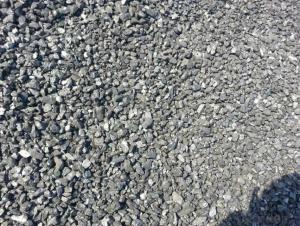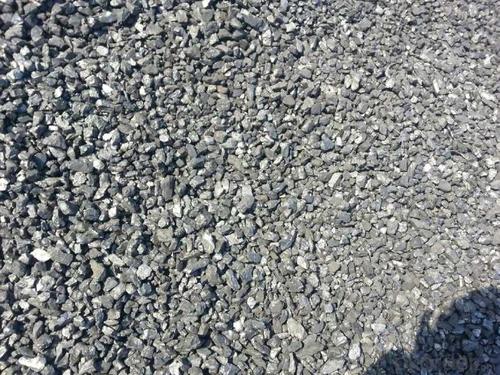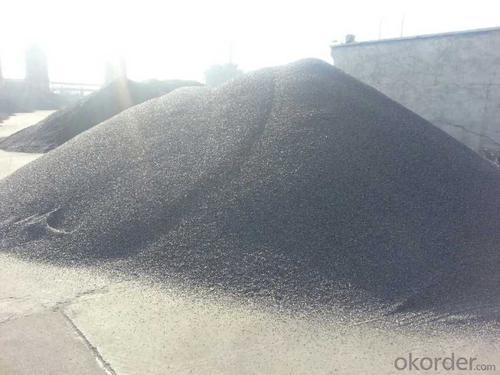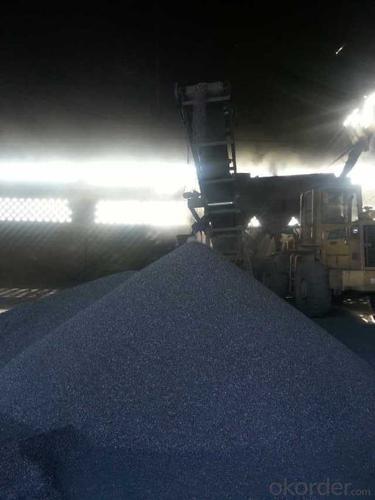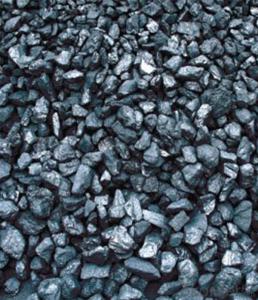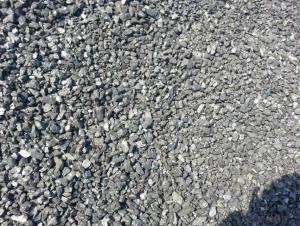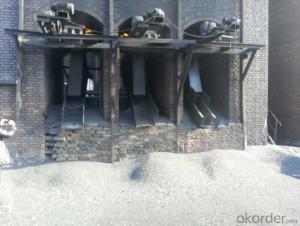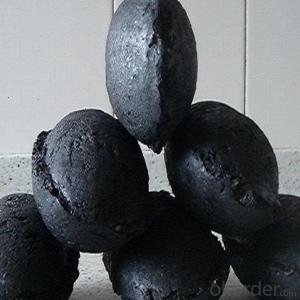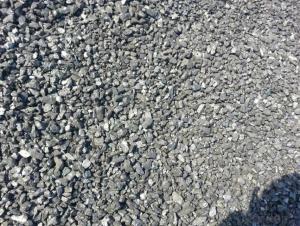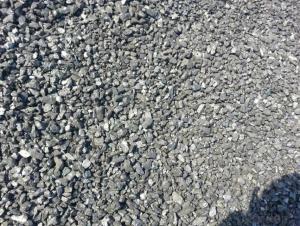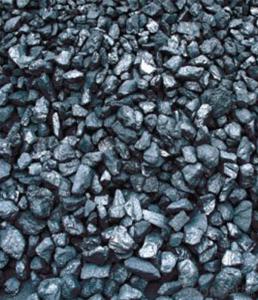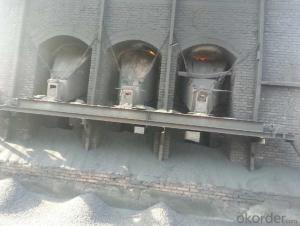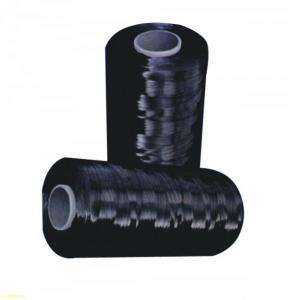Recarburizer FC80-90 with stable quality
- Loading Port:
- Tianjin
- Payment Terms:
- TT OR LC
- Min Order Qty:
- 20 m.t.
- Supply Capability:
- 3000 m.t./month
OKorder Service Pledge
OKorder Financial Service
You Might Also Like
Packaging & Delivery
25kgs/50kgs/1ton per bag or as buyer's request
Specifications
Calcined Anthracite
Fixed carbon: 90%-95%
S: 0.5% max
Size: 0-3. 3-5.3-15 or as request
It used the high quality anthracite as raw materials through high temperature calcined at over 2000 by the DC electric calciner with results in eliminating the moisture and volatile matter from anthracite efficiently, improving the density and the electric conductivity and strengthening the mechanical strength and anti-oxidation. It has good characteristics with low ash, low resistvity, low sulphur, high carbon and high density. It is the best material for high quality carbon products.
Advantage and competitive of caclined anthracite:
1. strong supply capability
2. fast transportation
3. lower and reasonable price for your reference
4.low sulphur, low ash
5.fixed carbon:95% -90%
6..sulphur:lower than 0.3%
General Specification of Calcined Anthracite:
| FC | 80 | 83 | 85 | 88 | 90 |
| ASH | 16 | 14 | 13 | 10 | 8.5 |
| V.M. | 3 | 3 | 2 | 2 | 1.5 |
| S | 0.5 | 0.5 | 0.5 | 0.5 | 0.35 |
| MOISTURE | 2 | 2 | 1 | 1 | 0.5 |
Pictures

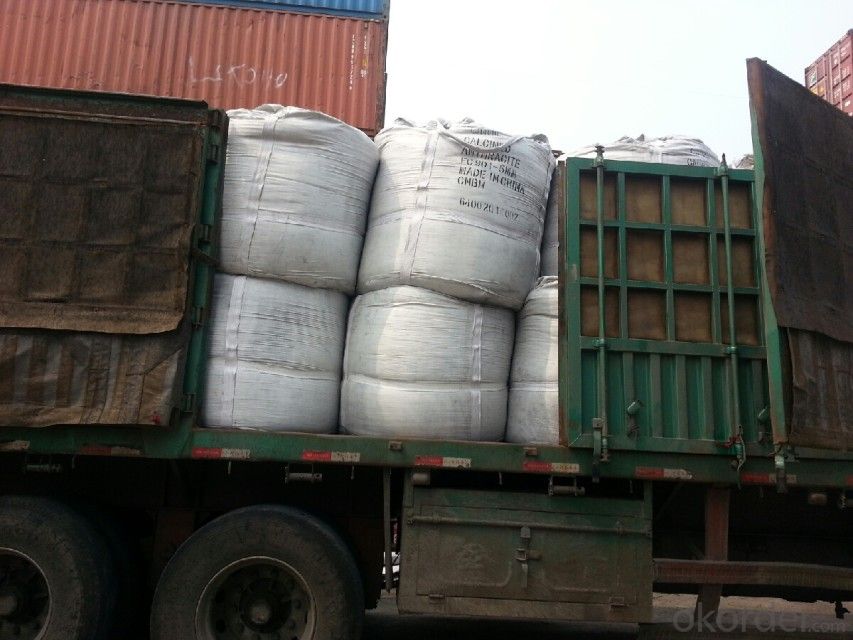
We are also strong at below materials, please contact us if you are interested in any of them:
Calcined Petroleum Coke
Carbon Electrode Paste
Carbon Electrode
- Q: What are the effects of carbon emissions on agriculture?
- Carbon emissions have numerous detrimental effects on agriculture. Firstly, increased levels of carbon dioxide (CO2) in the atmosphere contribute to global warming, leading to changes in rainfall patterns and more frequent extreme weather events such as droughts, floods, and heatwaves. These weather conditions disrupt agricultural production by reducing crop yields, damaging crops, and increasing the prevalence of pests and diseases. Higher temperatures also accelerate the rate of evaporation, resulting in soil moisture deficits and water scarcity, which negatively impact crop growth and productivity. In addition, elevated CO2 levels can alter the nutritional content of crops, reducing their quality and nutritional value. For example, studies have shown that increased CO2 concentrations can decrease the protein content in wheat and rice, leading to potential health issues for those who rely on these staple crops. Furthermore, carbon emissions contribute to the formation of ground-level ozone, a harmful air pollutant. Ozone damages plant cells, inhibits photosynthesis, and reduces crop yields. It particularly affects sensitive crops such as soybeans, wheat, and cotton. The effects of carbon emissions on agriculture are not limited to crop production. Livestock farming is also impacted as rising temperatures and water scarcity make it more challenging to maintain adequate grazing lands and provide sufficient water and fodder for animals. Additionally, changes in climate patterns can lead to the spread of livestock diseases and pests, further endangering the livestock industry. Overall, carbon emissions have a cascading effect on agriculture, leading to reduced crop yields, lower nutritional value, livestock farming challenges, and increased vulnerability to pests, diseases, and extreme weather events. Addressing and mitigating carbon emissions is crucial to safeguarding global food security and ensuring the sustainability of agricultural systems.
- Q: What are the consequences of increased carbon emissions on vulnerable communities?
- Vulnerable communities bear the brunt of severe consequences caused by the increase in carbon emissions. To begin with, these communities lack the necessary resources and infrastructure to adapt to and alleviate the impacts of climate change. The contribution of carbon emissions to global warming makes it more likely for these communities to experience extreme weather events, such as hurricanes, floods, and heatwaves. Consequently, displacement, loss of homes, and even loss of lives disproportionately affect those who are already marginalized. Moreover, the rise in carbon emissions leads to air pollution, which poses significant health risks to vulnerable communities. Inhabitants of low-income areas often reside in close proximity to industrial plants or highways with high emission levels, increasing their vulnerability to respiratory diseases, cardiovascular problems, and other health issues. This is particularly true for children, the elderly, and individuals with pre-existing health conditions. The consequences of increased carbon emissions also extend to food security. Climate change disrupts agriculture and alters the timing of growing seasons, resulting in reduced crop yields and food shortages. Vulnerable communities heavily dependent on subsistence farming or residing in areas prone to droughts or floods are at risk of malnutrition and hunger. This further aggravates existing inequalities and can lead to social unrest and economic instability. Furthermore, vulnerable communities often rely on natural resources, such as fishing, forestry, or tourism, for their livelihoods. The negative impacts of carbon emissions, such as ocean acidification and coral bleaching, jeopardize these industries, leading to job losses and economic decline. This perpetuates the cycle of poverty and socio-economic vulnerability. In conclusion, increased carbon emissions disproportionately harm vulnerable communities by exacerbating existing inequalities and intensifying the challenges they face. It is crucial to address these consequences through climate mitigation efforts, adaptation strategies, and support for sustainable development.
- Q: What is carbon offsetting in the energy sector?
- Carbon offsetting in the energy sector refers to the practice of balancing out the release of carbon emissions into the atmosphere by investing in projects that reduce or remove an equivalent amount of carbon dioxide from the atmosphere. It aims to neutralize the environmental impact of energy production and consumption by supporting renewable energy projects, reforestation efforts, or other initiatives that reduce greenhouse gas emissions.
- Q: Carbon content of fly ash and fly ash roasted vector what is the relationship?
- The higher the carbon content, the greater the adsorption, the lower the activity index.In the process of coal ash processing, there are still many places to use the fly ash mill. The carbon content of fly ash is related to the boiler property and combustion technology. China's newly built modern power plant, the content of fly ash can be reduced to l% ~ 2%, and some power plants may also be as high as 20%.
- Q: How does carbon impact the prevalence of tropical storms?
- The prevalence of tropical storms is greatly influenced by carbon, specifically carbon dioxide (CO2) emissions. Human activities like burning fossil fuels, deforestation, and industrial processes have led to an increase in atmospheric CO2 levels, resulting in global warming. This phenomenon of rising global temperatures has various implications for the formation and intensity of tropical storms. To begin with, warmer temperatures lead to higher levels of moisture in the atmosphere due to increased evaporation of seawater. Moisture is crucial for the development and sustenance of tropical storms as it provides the necessary fuel. With more moisture available, the potential for tropical storms to form and strengthen is enhanced. Moreover, rising global temperatures cause tropical oceans to expand, providing a larger area for tropical storms to form and intensify. This expansion allows for greater energy exchange between the ocean and the atmosphere, further enhancing the potential for storm development. Additionally, elevated levels of CO2 contribute to ocean acidification, which negatively affects marine ecosystems like coral reefs. Coral reefs act as natural barriers that protect coastal areas from storm surges and waves generated by tropical storms. However, the acidification of oceans weakens and destroys these reefs, leaving coastal regions more vulnerable to storm impacts. Lastly, carbon emissions causing climate change alter atmospheric and oceanic circulation patterns, which can affect the movement and tracks of tropical storms. Changes in wind patterns and ocean currents may cause storms to deviate from their usual paths, leading to increased uncertainty and potential impacts on regions not typically prone to these events. In summary, carbon emissions and the resulting global warming have significant effects on the prevalence of tropical storms. Increased moisture content, expanded warm ocean areas, weakened coastal defenses, and altered storm tracks are all consequences of rising carbon levels, ultimately contributing to more frequent and intense tropical storms.
- Q: What is the carbon footprint of different activities?
- The carbon footprint of different activities refers to the amount of greenhouse gas emissions, particularly carbon dioxide (CO2), that are released into the atmosphere as a result of carrying out those activities. It is a measure of the impact that these activities have on climate change. Various activities contribute to our carbon footprint, including transportation, energy use, food production, and waste management. The carbon footprint of each activity can vary significantly depending on factors such as the type of energy sources used, the efficiency of technologies involved, and individual choices. Transportation is a major contributor to carbon emissions, with cars, planes, and ships being the primary sources. The use of fossil fuels in these modes of transportation releases CO2 into the atmosphere. The type of vehicle, fuel efficiency, and distance traveled all play a role in determining the carbon footprint of transportation. Energy use is another significant contributor, particularly in the form of electricity generation. Burning fossil fuels like coal and natural gas to produce electricity releases CO2. However, renewable energy sources like wind, solar, and hydroelectric power have a lower carbon footprint as they do not emit greenhouse gases during operation. Food production is often overlooked but has a substantial carbon footprint. The agricultural practices involved in growing, processing, packaging, and transporting food contribute to emissions. Additionally, livestock farming, particularly beef and lamb, produces significant amounts of methane, a potent greenhouse gas. Waste management also contributes to carbon emissions, primarily through the decomposition of organic waste in landfills. As organic waste breaks down, it produces methane. Proper waste management techniques, such as composting and anaerobic digestion, can help reduce these emissions. It is important to note that the carbon footprint of activities can be reduced through various measures. Adopting energy-efficient technologies, using public transportation or carpooling, choosing renewable energy sources, eating a more sustainable diet, and practicing proper waste management are all ways to minimize our carbon footprint. Understanding the carbon footprint of different activities allows individuals, businesses, and governments to make informed decisions and take necessary actions to mitigate climate change. By reducing our carbon footprint, we can contribute to a more sustainable and environmentally-friendly future.
- Q: How does carbon affect the formation of landslides?
- Carbon does not directly affect the formation of landslides. Landslides are primarily triggered by natural factors such as heavy rainfall, earthquakes, or volcanic activity, or by human activities such as deforestation or construction. However, carbon indirectly plays a role in landslides through its impact on the environment. Excessive carbon dioxide (CO2) emissions, primarily caused by human activities such as burning fossil fuels and deforestation, contribute to climate change. Climate change leads to more frequent and intense rainfall events, which can increase the likelihood of landslides. Increased rainfall can saturate the soil, making it heavier and more prone to sliding, especially on steep slopes. Another way carbon can indirectly affect landslides is through deforestation. Trees play a crucial role in stabilizing slopes by anchoring the soil with their root systems. When forests are cleared for agriculture, urbanization, or logging, the loss of tree cover weakens the soil's stability and increases the risk of landslides. Additionally, the removal of vegetation reduces the absorption of rainfall, leading to increased surface runoff and erosion, further destabilizing slopes and making them more susceptible to landslides. In conclusion, while carbon itself does not directly cause landslides, its impact on climate change and deforestation can indirectly contribute to the occurrence and severity of landslides. It is important to address carbon emissions and promote sustainable land management practices to mitigate the risk of landslides and maintain the stability of slopes.
- Q: What should I do when carbon monoxide leaks?
- Of course, in saving at the same time, to find out the cause of the gas leak as soon as possible, and to other people and then plugging, lest suffer. PoisoningTo avoid leakage and gas poisoning accident occurred in the home, can install household gas alarm detector | gas leak alarm, it can predict in advance the gas leak alarm, prompting the user, open the window as soon as possible to prevent accidents.
- Q: How is carbon used in the production of carbon fiber?
- Carbon is a crucial component in the production of carbon fiber. Carbon fibers are made by subjecting a precursor material, usually a type of polymer such as polyacrylonitrile (PAN) or rayon, to a series of heating and chemical treatments. The precursor material is first heated to a high temperature in the absence of oxygen, a process known as carbonization. During this stage, the precursor undergoes pyrolysis, which breaks down the molecular structure and removes non-carbon elements like hydrogen, oxygen, and nitrogen. After carbonization, the resulting material is a carbon-rich structure known as a carbonized fiber or char. However, the material is still not considered carbon fiber at this point. To transform the char into carbon fibers, it undergoes further processing steps called stabilization and graphitization. During stabilization, the char is heated in the presence of oxygen, which leads to the formation of cross-linked structures. This step helps to improve the fiber's thermal stability and prevents it from shrinking or deforming during subsequent processing. The stabilized material is then heated to a higher temperature in an inert atmosphere during graphitization. This process aligns the carbon atoms within the fiber, creating a highly ordered and crystalline structure. Throughout this entire process, carbon is the main building block of the resulting carbon fiber. Starting from the precursor material, which contains carbon atoms, the carbonization and graphitization steps remove impurities and rearrange the carbon atoms to form a strong and lightweight fiber. The resulting carbon fiber exhibits exceptional properties such as high strength-to-weight ratio, stiffness, and resistance to heat and chemicals, making it a valuable material in various industries, including aerospace, automotive, and sporting goods.
- Q: How does carbon impact the availability of clean energy solutions?
- The availability of clean energy solutions is significantly affected by carbon. Climate change, caused mainly by carbon emissions from burning fossil fuels and human activities, poses a serious threat to the environment and human well-being. Therefore, there is an urgent need to transition to cleaner energy sources that emit less carbon. Clean energy solutions, such as solar and wind power, have the potential to greatly reduce carbon emissions. These energy sources generate electricity without burning fossil fuels, resulting in minimal to no carbon emissions. By replacing traditional energy sources with clean alternatives, we can decrease our carbon footprint and mitigate climate change. However, the presence of carbon emissions impacts the availability and scalability of clean energy solutions in multiple ways. Firstly, the continued dependence on carbon-intensive energy sources, like coal and oil, hampers the rapid adoption of clean energy technologies. The existing infrastructure and investments in fossil fuel-based energy systems make it challenging to transition to clean alternatives. Secondly, carbon emissions contribute to global warming, which affects the availability and efficiency of certain clean energy solutions. For instance, higher temperatures can decrease the effectiveness of solar panels and affect the output of hydropower due to changes in rainfall patterns. This emphasizes the significance of reducing carbon emissions to ensure the long-term viability and efficacy of clean energy technologies. Moreover, carbon emissions have economic implications that can influence the availability of clean energy solutions. Governments and policymakers play a crucial role in encouraging the adoption of clean energy through regulations, subsidies, and carbon pricing mechanisms. These policies can impact the affordability and accessibility of clean energy technologies, making them more appealing to investors and consumers. In conclusion, carbon emissions have a profound impact on the availability of clean energy solutions. By reducing carbon emissions and transitioning to cleaner energy sources, we can mitigate climate change, enhance the efficiency of clean energy technologies, and create a more sustainable future. It is crucial for governments, businesses, and individuals to prioritize the development and adoption of clean energy solutions to ensure a cleaner and healthier planet for future generations.
Send your message to us
Recarburizer FC80-90 with stable quality
- Loading Port:
- Tianjin
- Payment Terms:
- TT OR LC
- Min Order Qty:
- 20 m.t.
- Supply Capability:
- 3000 m.t./month
OKorder Service Pledge
OKorder Financial Service
Similar products
Hot products
Hot Searches
